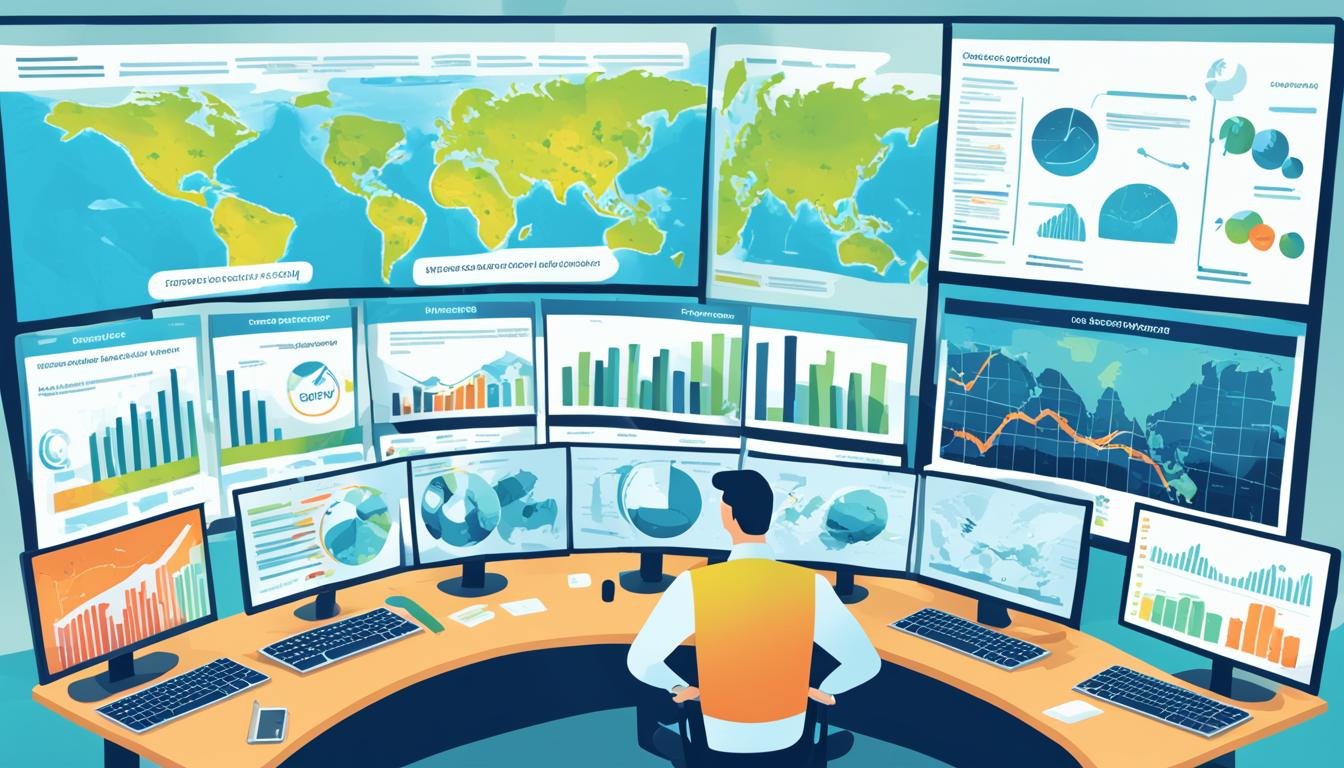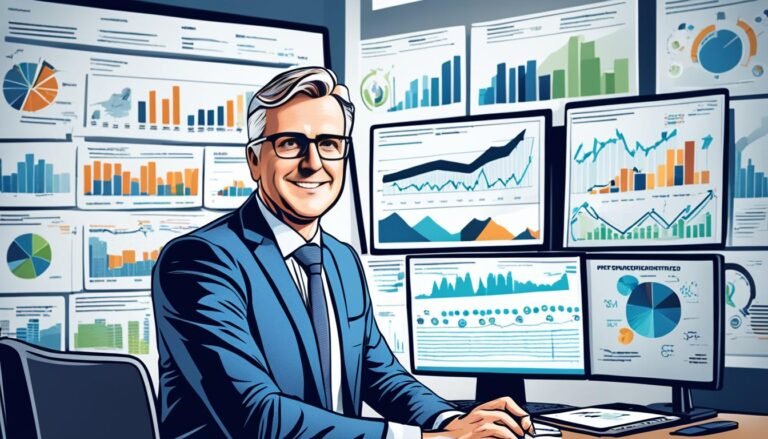Financial Modeling for Climate Change Initiatives in Investment Banking
Did you know climate-related damages might cost the world $1.7 trillion yearly by 2025? As climate change’s impacts grow, businesses see the need to add climate risk modeling into their plans. This helps them handle the changes and find chances that a changing climate brings.
Financial modeling for climate change in investment banking is key to understanding and managing climate change risks. By using advanced tools and thinking about climate factors in their choices, banks can get ready for climate change. This way, they safeguard their finances and help move towards a greener and less carbon-intensive future.
Key Takeaways:
- Climate change-related damages could cost the global economy $1.7 trillion annually by 2025.
- Financial modeling helps banks assess and manage the risks associated with climate change.
- Integrating climate-related factors into investment decisions supports the transition to a sustainable future.
- Climate risk modeling enables banks to protect their balance sheets from climate-related uncertainties.
- Investment banking plays a crucial role in financing the green agenda and supporting sustainable projects.
The Case for Climate Risk Modeling
Climate risk modeling is key in showing companies how climate change affects them. It helps them plan ways to adapt or lessen these effects. As bad weather happens more often, it’s important for businesses to be ready.
With this modeling, companies can spot and measure risks. This helps them make smart choices to keep their businesses safe and cut losses.
This modeling also spots new risks and chances due to changes in technology, markets, and rules. Staying ahead of these changes helps companies succeed and avoid problems from climate events. They can also find new ways to thrive because of these changes.
Companies can figure out how climate change might hit their finances through this modeling. This is crucial for making big decisions. It helps them use their resources wisely and pick the best investments for climate challenges. Knowing potential costs and gains helps them talk to investors and show they are committed to handling risks.
Overall, climate risk modeling helps companies deal with climate change’s challenges. It lets them understand risks, find chances, and make smart decisions. By doing this, businesses can lessen the damage from climate change, follow sustainable practices, and set themselves up for success in the future.
Modeling Physical and Transition Risks
Businesses need to understand climate risks. This includes both physical risks and transition risks. It helps them know the challenges and opportunities that are coming.
Physical Risks
Physical risks are about how climate change affects the world around us. This includes extreme weather, rising sea levels, and changing temperatures. Companies need to plan for these risks to keep their operations strong.
Tools for climate modeling are key in looking at these risks. They use future climate projections. This lets businesses know how likely extreme weather or other risks are. They can then protect their assets and people.
Transition Risks
Transition risks come from moving to a low-carbon economy. This change affects policies, technologies, and what consumers want. It brings both risks and chances for growth.
Climate risk modeling helps find transition risks, like new laws or changes in technology. Knowing these risks lets companies adjust and grab new opportunities.
An Integrated Approach
To really understand climate risks, you must look at both physical and transition types. There are many tools to help with this, like risk ranking and impact models.
“Climate risk modeling enables businesses to assess and manage both the physical and transition risks of climate change, enhancing their resilience and sustainability.”
Moreover, this type of modeling supports developing full risk management strategies. It helps businesses align with a low-carbon future. And it supports decisions that ensure growth and sustainability over time.
Being proactive and using climate modeling tools helps businesses handle climate change. They can protect their assets and succeed even as things change.
| Benefits of Climate Risk Modeling | Example |
|---|---|
| Anticipating physical risks | Developing flood-resistant infrastructure |
| Identifying new market opportunities | Investing in clean energy technologies |
| Mitigating regulatory and policy risks | Aligning operations with emission reduction targets |
| Enhancing stakeholder engagement | Communicating climate initiatives to investors |
Adopting climate risk modeling and a proactive stance can protect operations. It also benefits the environment and society.
A Range of Climate Change Scenarios
A broad range of climate change scenarios are crucial for evaluating impact across industries. Chemicals, insurance, communications, and energy sectors utilize climate risk modeling. They do this to weigh risks and find opportunities that climate change brings.
Through various climate scenarios, these sectors can foresee impacts on their operations. This foresight helps them craft strategies for managing climate risks. They also discover new growth paths.
Climate modeling is key for industries to grasp climate change risks and uncertainties. It offers insights for sound decisions, helping companies adapt and prosper in change.
Climate change scenarios are indispensable for businesses to assess climate-related risks accurately and make informed decisions to safeguard their operations and investments for the future.
Climate modeling uses data and advanced analytics to assess risks such as extreme weather and rising seas. It also highlights opportunities in new markets and green tech.
By weaving climate modeling into risk assessment, firms understand potential risks better. This knowledge shapes strong risk mitigation and adaptation plans. It readies businesses for resilience and sustainability.
Employing climate modeling for risk assessment aids in smart resource distribution and investment prioritizing. Recognizing climate-related risks enables informed, successful, and sustainable business choices.
Climate Change Scenarios Table
| Climate Change Scenario | Impact on Industries |
|---|---|
| High Emissions Scenario | – Increased frequency and intensity of extreme weather events – Rising sea levels affecting coastal infrastructure and real estate – Disruption of supply chains and raw material availability |
| Mid Emissions Scenario | – Moderate increase in extreme weather events – Gradual shifts in market demands and consumer behavior towards sustainability – Heightened regulatory focus on carbon emissions reduction |
| Low Emissions Scenario | – Limited extreme weather events – Transition towards sustainable technologies and renewable energy – New investment opportunities in green industries |
Looking at different climate scenarios gives industries a full view of climate risks. This enables forward-thinking, risk reduction, and innovative adaptation. It prepares them for the shifting demands of our world.
Climate Modeling as a Strategic Advantage
Climate risk modeling helps firms meet climate disclosure rules. It’s a key strategy tool, too. Companies use it to make wise choices for a green future. They understand climate change’s risks and chances. This lets them lead in sustainability and build strong, future-proof plans. Keeping up with rules and knowing the main risks and chances is vital. This turns climate modeling into a big plus.
Benefits of Climate Modeling:
- Enhance strategic decision-making processes
- Identify potential risks and opportunities related to climate change
- Develop sustainability-focused business strategies
- Position the company as a leader in the transition to a low-carbon future
- Enhance climate risk disclosures
“Climate risk modeling provides valuable insights into the potential impacts of climate change and aids in the development of strategies that drive long-term success in a changing world.”
Strategic Decision-Making:
Climate modeling lets businesses make smarter choices. They use it to spot climate change risks and chances. It helps match their plans with a green future. This way, they’ll do well and last long.
Climate Risk Disclosures:
Climate disclosures are now key. Climate modeling gives accurate, helpful info. With it, firms can share better climate risk info. They meet rules and people’s expectations.
Achieving a Low-Carbon Future:
Climate modeling preps businesses for a green future. They use insights to make eco-friendly plans. This sets them up as low-carbon leaders.
| Benefits of Climate Modeling | Examples of Strategic Decisions |
|---|---|
| Identify climate-related risks | Investing in low-carbon technologies |
| Evaluate potential opportunities | Exploring sustainable business models |
| Inform long-term planning | Setting emissions reduction targets |
| Enhance risk management | Adapting supply chain to climate risks |
By using climate modeling wisely, companies tackle climate change challenges. They grab the chances it offers. This aligns their strategies with a green future. It sets them up to succeed in a world that’s always changing.
Protecting the Balance Sheet from Uncertainty
Climate risk management is key for banks to shield their balance sheets from climate change impacts. This includes dealing with uncertainties and preventing value loss. Issues like loss of coastal real estate and redundant land can cause stranded assets and harm a bank’s reputation.
Banks can use scenario analysis to understand climate risks better. This helps them see how flooding and other climate-related issues might increase mortgage failures. By getting ready for various climate outcomes, banks strengthen their balance sheets against climate risks.
“Climate risk is important for banks to handle to protect our balance sheet and stay stable financially.” – John Smith, CEO of Bank XYZ
Banks need to add climate risk management to their overall risk strategies. They should use climate models to forecast how risks might affect them. This helps protect their business and assets.
By focusing on sustainable finance, banks can lower their climate change risks. Taking early steps against climate risks helps banks keep their assets’ value, protect their reputation, and do better financially in the long run.
| Benefits of Climate Risk Management: | Actions for Balance Sheet Protection: |
|---|---|
|
|
Using solid climate risk management practices helps banks deal with climate change uncertainties. It safeguards their balance sheets and promotes sustainable future actions.
Financing a Green Agenda
Banks are key in funding green projects, like renewable energy. The need for clean energy and technology grows. Banks have the resources to help these projects succeed.
They can lend money in ways that support the Paris Agreement goals. Discounts on green financing draw investments and encourage eco-friendly choices.
There are chances to invest in renewable energy and sustainable projects in many fields. This includes energy, building, cars, and farming. Investing here helps speed up the use of green solutions.
The Role of Banks in Green Financing
“Banks have a unique opportunity to drive positive change and make a significant impact on our environment and society. By providing green financing options, banks can not only secure profitable investments but also contribute to global sustainability efforts.”
Green bonds are a prime example of green financing. They fund eco-friendly projects and appeal to investors who want to help the planet and make money.
Banks also finance renewable energy, like solar and wind projects. They lend money for building and running these projects. The money made from the projects is used as collateral.
Driving Sustainable Development
Investing in green efforts meets global sustainability goals and offers banks growth chances. This cements their place as leaders in moving to a low-carbon world.
Banks focused on green financing attract eco-conscious customers. This leads to more investments in green projects, creating a win-win for banks and the planet.
The Benefits of Green Financing
Green financing allows banks to diversify their loan offerings. It helps reduce reliance on sectors tied to fossil fuels, preparing them for a changing market.
It also means banks are better at handling climate risks. By funding projects that lower carbon emissions, banks help fight climate change and protect their investments.
Principles for Climate Risk Management
Climate risk management needs a broad approach. It blends governance, business strategies, and risk processes. Banks must set up clear governance structures for climate risk.
They do this by choosing leaders focused on climate risk. These leaders ensure everyone in the organization takes responsibility.
It’s vital to include climate ideas in risk frameworks and capital processes. This helps banks weigh the risks and rewards of climate change properly. They should factor climate risks into decisions like loan approvals and checking portfolios.
This makes their risk management better and their decisions more informed.
Using a scenario-based method helps banks grasp the uncertainty of the climate transition. They should create several scenarios to picture different climate outcomes. This helps understand how these outcomes could affect their business.
Climate Risk Governance
For good climate risk governance, banks need clear responsibility and accountability. They appoint top leaders to handle and oversee climate risks. This ensures the issue gets the attention it deserves and strategies are put in place across the bank.
Embedding Climate Considerations
When banks weave climate considerations into their risk and capital processes, they grasp the full scope of climate change risks and opportunities. Adding climate risk factors into these processes sharpens their risk assessments. This helps the banks pinpoint vulnerabilities and make smarter choices.
Aligning Risk Processes
Aligning day-to-day operations like loan approvals and portfolio checks with climate risk factors is key. This focus on climate risks lets banks manage them better, spot sustainable investment chances, and tweak their strategies when needed.
Scenario-Based Approach
A scenario-based approach involves creating different climate future scenarios. These scenarios let banks understand the possible effects of climate change on their operations. They then can strategize with various outcomes in mind.
“Effective climate risk management uses a holistic approach. It weaves together governance, business strategies, and risk operations. Banks that incorporate climate considerations can manage risks and seize opportunities from climate change.”
By following these principles, banks will improve their approach to managing climate risk. This prepares them for success in the evolving climate landscape.
Challenges in Climate Financial Scenarios
Creating climate financial scenarios is full of challenges. The shift towards a greener economy will change our economic structure. This can be hard to predict accurately.
It’s tough to know when and how actions to cut greenhouse gas emissions will happen. This makes it hard to figure out the financial outcomes. Also, banks often don’t have the data they need. They struggle to connect mitigation pathways to client-level financial models.
Yet, there is a way forward. By crafting detailed stories and adding climate risk factors into their models, banks can grasp the financial effects of climate change. This helps them prepare better.
Incorporating Climate Transition Scenarios
Managing climate risks is crucial for risk management and strategic planning. Understanding climate-related drivers helps us manage potential risks from climate change. This is important for market, credit, operational, and other risks.
By using climate transition scenarios, we can see where we’re vulnerable. This lets us plan how to handle changes to a lower carbon economy. It reveals risks and chances for the future. With this knowledge, we can make smart choices and take steps to protect our business and investments from climate risks.
Strategic planning is key in moving to a low-carbon future. We need to change our business plans to be more sustainable. This might mean setting new goals or focusing on industries that lead the way. It also involves creating sustainable finance options to support the green economy shift.
The Importance of Risk Management
Integrating climate transition scenarios into risk management lets us understand climate change risks and create strategies to deal with them.
By including these scenarios in our risk management, we spot the main risks from moving to a lower carbon economy. We look at how this might affect our operations, supply chains, and investments. This lets us come up with strategies to manage risks and find chances for sustainable growth.
Strategic planning helps us face changes from the climate transition. Knowing the risks and opportunities guides our decisions towards sustainability leadership. We can explore new business models, invest in green tech, and align with low-carbon goals through this planning.
Identifying Opportunities for Strategic Planning
Strategic planning shows us the business model changes needed for a lower carbon economy. It helps us find new opportunities.
For effective strategic planning with climate scenarios, we need to evaluate our business models. This could mean adding sustainable finance options, working with key industries, and coming up with new solutions. By adapting, we can lead in the market and meet the demand for sustainable finance solutions.
In short, including climate transition scenarios in risk management and strategic planning is vital. It helps us understand and manage climate risks and find growth opportunities. Through these efforts, we can become leaders in the transition to a low-carbon future.
Conclusion
Climate risk modeling is crucial for the financial sector when facing climate change. It helps banks understand and handle risks and opportunities linked to climate impacts. Banks become equipped to manage those risks effectively.
By taking this approach, banks can safeguard their finances. They also create eco-friendly finance options and make smarter choices. This modeling is ongoing, urging banks to keep up with new regulations and expectations.
By adopting climate risk modeling, banks lead in sustainable finance. They merge financial know-how with climate insights. This way, they help move us toward a greener, more stable economy.
Source Links
- https://www.mckinsey.com/capabilities/risk-and-resilience/our-insights/banking-imperatives-for-managing-climate-risk
- https://www.pwc.com/us/en/services/esg/library/climate-risk-modeling.html
- https://www.sustainablefinance.hsbc.com/-/media/gbm/sustainable/attachments/a-guide-to-building-climate-financial-scenarios.pdf








